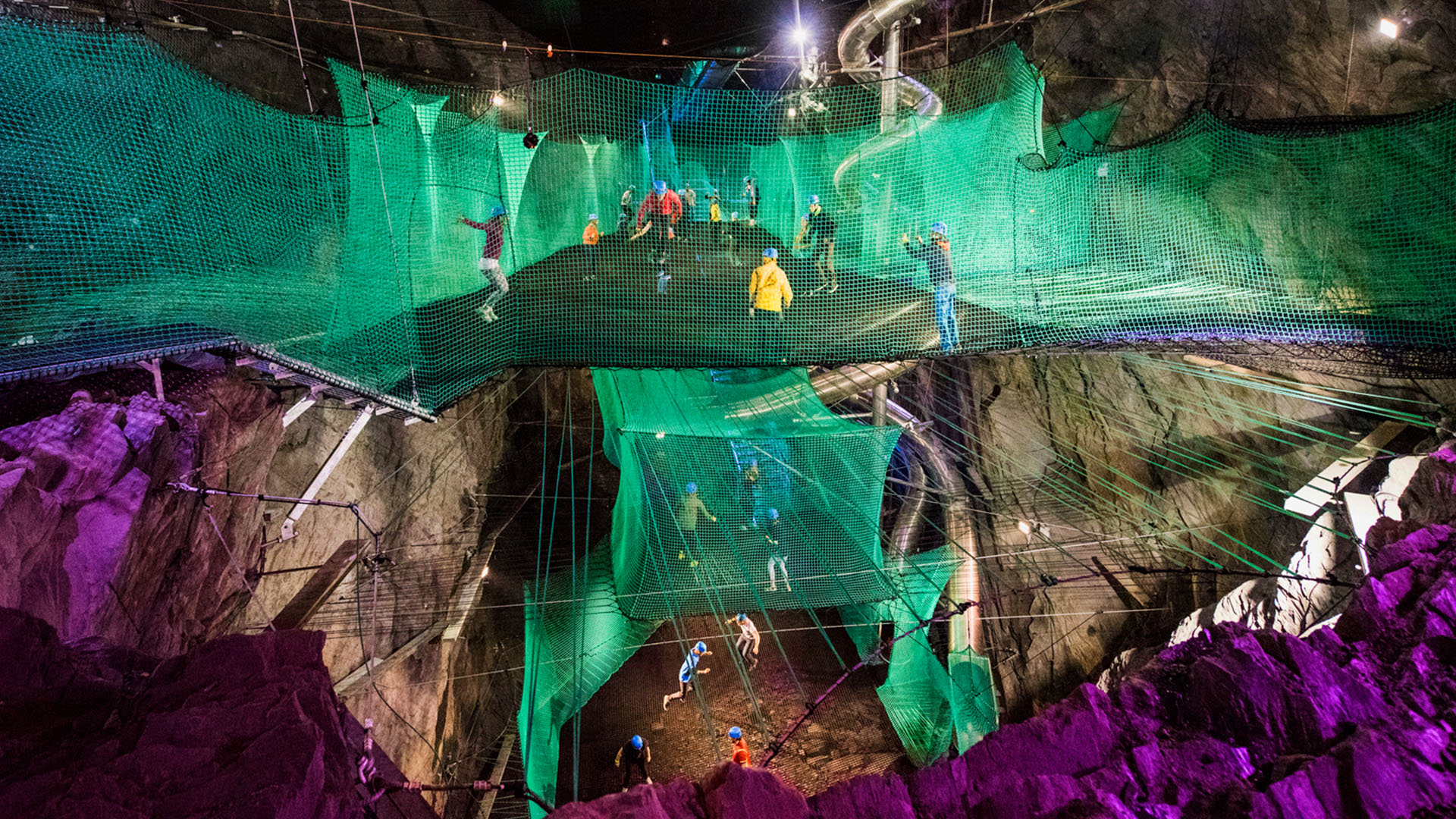
It’s often said that old mining quarries leave a scar on the landscape, but it doesn’t have to be that way if they are put to good use once their mining days are done. From football stadiums to a giant underground trampoline park, all it takes is a bit of ingenuity to turn a disused quarry into a major asset.
Here are eight of the finest examples from around the world of former mines that are enjoying a second lease of life.

The Eden Project, Cornwall
Eden Project, Cornwall, UK
The Eden Project in Cornwall, south west England, is probably the most famous example of a repurposed quarry. The old china clay works were a scar on the surrounding landscape until, 20 years ago, geodomes turned the site into one of Britain’s most famous and popular tourist attractions. Its industrial origins are unrecognisable now but, although it may be the most successful reimagining, it is not unique in breathing new life into these redundant locations.

The Salt Cathedral of Zipaquirá, Columbia
The Salt Cathedral of Zipaquirá, central Colombia
Two hundred metres under the mountains of central Colombia, a little north of Bogotá, abandoned salt mines are the setting for this extraordinary church. Largely built in the 1990s to replace an earlier creation, the cathedral is, in fact, more than a dozen chapels connected by the old mine tunnels and has become a place of pilgrimage, attracting 3,000 worshippers on Sundays as well as many thousands of tourists during the week.

Dalhalla concert hall, Sweden
Concert Hall, near Rättvik, central Sweden
Small-town central Sweden was perhaps not the obvious place to build an outdoor opera venue, but when retired singer, Margaret Dell Fors, saw the 60m-deep crater formed by an old limestone quarry, she persuaded the local authority to turn it into one, arguing that the acoustics and stark geology would prove a winning combination. She was right: finished in 1995, Dalhalla now holds summer festivals with guests as varied as the Bolshoi Ballet, Patti Smith and Björk.
Photo: Wieliczka Health Resort

Wieliczka health resort
Health Farm, Daniłowicza, southern Poland
Just south of Krakow is Daniłowicza’s underground health farm, where you can relax and forget about your above-ground stresses. According to Wieliczka Salt Mine’s publicity, “the unique characteristics of the underground micro-climate” guard against asthma, allergies, bronchitis and chronic obstructive pulmonary disease (COPD). Visitors can stay at the facility near Krakow, 135m below the surface and benefit from the purity of its air as well as a range of treatments including water therapy and breathing exercises.
Photo: Bounce Below

Bounce Below, Wales
Trampoline Park, Blaenau Ffestiniog, west Wales
A series of tunnels lead visitors into a cavern within a former slate mine which is, its owners claim, big enough to fit London’s St Paul’s Cathedral. Strung across it, a series of nets and slides which makes Bounce Below in the Snowdonia National Park, the world’s biggest – and most spectacular – trampoline centre.
Photo: Iron Mountain; Kinkade Photo / Bryan Kinkade

Iron Mountain Data Centre, Boyers
Data Centre, near Boyers, west Pennsylvania, US
For those worried about data security, Iron Mountain should provide some reassurance – north of Pittsburgh, the 220-acre site is almost 70m deep and built in the chambers of a limestone mine. The company says that this makes it extremely safe from all man-made and environmental disasters and that employees enjoy the consistent temperatures achieved from being so far underground.
Photo: SC Braga

Braga Stadium, Portugal
Football Stadium, Braga, northern Portugal
The 30,000-capacity home ground of Sporting Braga is known locally as A Pedreira or the Quarry. Built in 2003 in a former granite quarry as one of the venues for the UEFA Euro 2004 tournament, the stands nestle within the quarry walls and one of the goals is carved into the rockface. Its stunning design, exploiting the local topography, contributed to its architect winning the Pritzker Prize in 2011.
Photo: Wikipedia

Athletics Track, Yanahara, Japan
Athletics Track, Yanahara, south west Japan
In the process of decommissioning an iron-ore mine, researchers found that its low levels of oxygen were similar to the high-altitude “hypoxic” training sites popular with professional athletes. Unlike mountain facilities, however, this track maintains a constant temperature and humidity making it an ideal, weather-proof location for elite runners.

